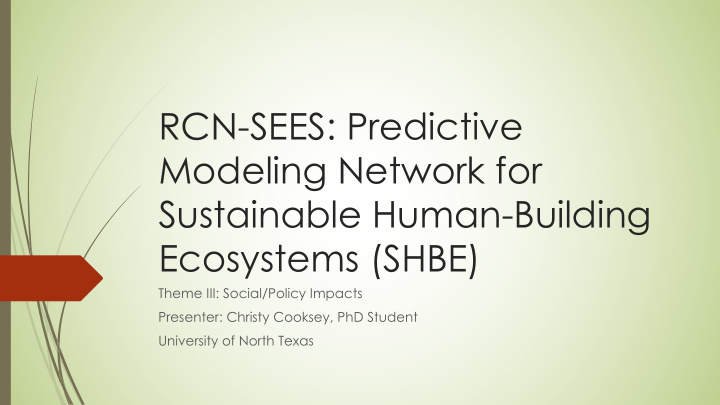



RCN-SEES: Predictive Modeling Network for Sustainable Human-Building Ecosystems (SHBE) Theme III: Social/Policy Impacts Presenter: Christy Cooksey, PhD Student University of North Texas
City Characteristics that Influence Participation in Sustainability Programs • Introductions • Theme III- Social/Policy Implications • Importance of Research to Theme III
Background • Defining Sustainability • “Meet the needs of the present without compromising the ability of future generations to meet their own needs” (WCED, 1987). • “In which each individual has the opportunity to develop himself in freedom, within a well-balanced society and in harmony with its surroundings” (Van der Kerk and Manuel, 2010). • Three Pillars of Sustainability/ The Three E’s • Environmental resilience • Economic Vitality • Social Equity
Background • Leaders of City Sustainability • Adopt and implement programs designed to protect resources for future generations while maintaining freedom of choice for residents • Utilizing sustainable indicators to measure progress (Reflexivity) • Encourage sustainable practices through • Education (primary, secondary, and post-secondary) • Ease of use (location of recycle bins within close proximity of social groups) • Reward systems for businesses and individuals • Incentives such as tax breaks for sustainable practices (installing solar panels)
Statement of the Problem • Continued population growth • Heavy reliance on technology • Traditional development • In opposition to environmental protectionism • Resource depletion • In a growing, globalized society, difficulties arise with the inherent opposition of an individualized competition for economic advancement and an altruistic concern for the future of our environment which is undoubtedly experiencing stress.
Data County and City Data book (2007) • Crime • Total Number of Violent Robberies • Total Property Crime Number • Expense of Police Protection • Environmental • Average Temperature between 1971 and 2000 for January • Maximum Temperature between 1971 and 2000 for July • Annual Precipitation in Inches between 1971 and 2000 • Climate Heating Degree Days between 1971 and 2000 • Economy • Employment Totals • Unemployment Totals • Civilian Labor Totals •
Data ´ ICSD Baseline greenhouse gas emissions of the community Greenhouse gas reduction targets for businesses Greenhouse gas reduction targets for multi-family residences Greenhouse gas reduction targets for single-family residences Residential zoning codes to permit solar installations, wind power, or other renewable energy production Fast track plan reviews and or inspections for environmentally friendly development Reduce fees for environmentally friendly development A program for the purchase or transfer of development rights to create more efficient development Provide financial support/incentives for affordable housing Provide supportive housing to people with disabilities Provide housing options for the elderly
Provide housing within your community to homeless persons Provide access to information technology for persons without connection to the internet Provide funding for pre-school education Provide after-school programs for children Report on community quality of life indicators, such as education, cultural, diversity, and social well-being Restriction on purchase of bottled water by the local government Use of public land for community gardens Support a local farmer’s market Education program in the local community dealing with the environment and energy conservation Locate recycling containers close to refuse containers in public spaces such as streets and parks Green product purchasing policy in local government
Methodology • CCDB and ICSD Merge • Exploratory Factor Analysis • Used to identify latent concepts among 25 manifest variables measuring city participation in programs designed to increase sustainability. • Checked scale for reliability and deleted items within the factors which did not meet a .7 criteria for Cronbach’s Alpha. • Why FA was chosen • Sustainability is a concept • FA was necessary to capture the concept of sustainability.
Factor Loadings Communality Variable F 1- F 2-Social F 3- H j2 Environment Inclusion Economy 1. Income Tax -.003 .002 .717 .514 2. Per Capita Own Source Revenue .053 .328 .412 .280 3. Greenhouse gas reduction targets .889 .068 .011 .795 for businesses 4. Greenhouse gas reduction targets .957 .042 -.016 .917 for residences 5. Greenhouse gas reduction targets .940 .039 -.020 .865 for single-family residences 6. Provide financial support/incentives -.025 .633 .075 .406 for affordable housing 7. Provide supportive housing to people .077 .780 .012 .615 with disabilities 8. Provide housing options for the .030 .779 -.051 .605 elderly 9. Provide housing within your .086 .568 .155 .354 community to homeless persons Eigenvalues 2.874 2.578 1.332 % of Variance Explained 11.497 10.310 5.330
Analysis • Factor scale has been created from the chosen factors supporting sustainability • Factor scale scores will be used in analysis to determine city characteristics which impact the willingness to participate in sustainability programs
Conclusions • Findings support previous sustainability research which indicate a three pillar concept. The factors which were extracted were social, economic, and environmental. • Related back to workshop Theme III
Conclusions • Future Implications This project was intended to assess city characteristics that affect • participation in sustainability programs. Factor analysis has the power to reduce the amount of variables to a • few factors which measure a specific concept. This factor analysis addresses the burden of redundancy in regards to too many questions within a questionnaire designed to measure the same thing. • Limitations to study Data was not imputed due to the large number of missing after • merge was completed.
Recommend
More recommend